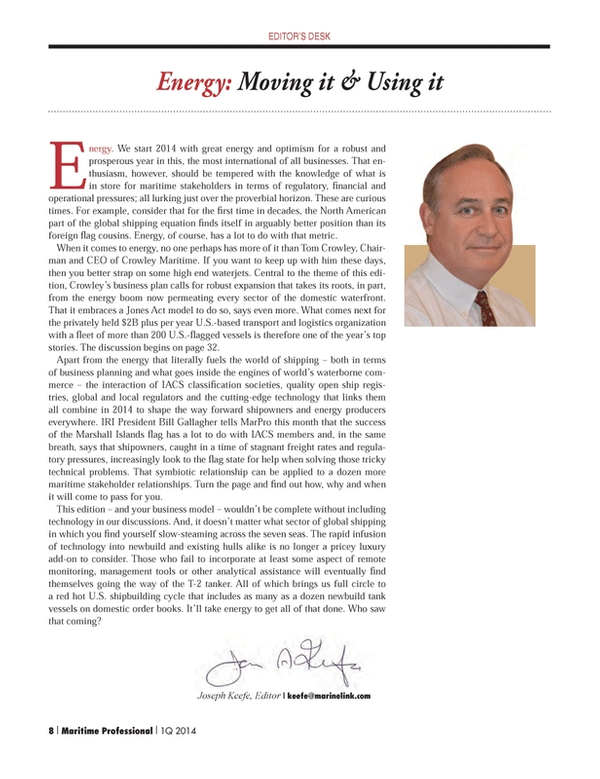
Energy: Moving it & Using it
Energy. We start 2014 with great energy and optimism for a robust and prosperous year in this, the most international of all businesses. That enthusiasm, however, should be tempered with the knowledge of what is in store for maritime stakeholders in terms of regulatory, financial and operational pressures; all lurking just over the proverbial horizon. These are curious times. For example, consider that for the first time in decades, the North American part of the global shipping equation finds itself in arguably better position than its foreign flag cousins. Energy, of course, has a lot to do with that metric.
When it comes to energy, no one perhaps has more of it than Tom Crowley, Chairman and CEO of Crowley Maritime. If you want to keep up with him these days, then you better strap on some high end waterjets. Central to the theme of this edition, Crowley’s business plan calls for robust expansion that takes its roots, in part, from the energy boom now permeating every sector of the domestic waterfront. That it embraces a Jones Act model to do so, says even more. What comes next for the privately held $2B plus per year U.S.-based transport and logistics organization with a fleet of more than 200 U.S.-flagged vessels is therefore one of the year’s top stories. The discussion begins on page 32.
Apart from the energy that literally fuels the world of shipping – both in terms of business planning and what goes inside the engines of world’s waterborne commerce – the interaction of IACS classification societies, quality open ship registries, global and local regulators and the cutting-edge technology that links them all combine in 2014 to shape the way forward shipowners and energy producers everywhere. IRI President Bill Gallagher tells MarPro this month that the success of the Marshall Islands flag has a lot to do with IACS members and, in the same breath, says that shipowners, caught in a time of stagnant freight rates and regulatory pressures, increasingly look to the flag state for help when solving those tricky technical problems. That symbiotic relationship can be applied to a dozen more maritime stakeholder relationships. Turn the page and find out how, why and when it will come to pass for you.
This edition – and your business model – wouldn’t be complete without including technology in our discussions. And, it doesn’t matter what sector of global shipping in which you find yourself slow-steaming across the seven seas. The rapid infusion of technology into newbuild and existing hulls alike is no longer a pricey luxury add-on to consider. Those who fail to incorporate at least some aspect of remote monitoring, management tools or other analytical assistance will eventually find themselves going the way of the T-2 tanker. All of which brings us full circle to a red hot U.S. shipbuilding cycle that includes as many as a dozen newbuild tank vessels on domestic order books. It’ll take energy to get all of that done. Who saw that coming?
(As published in the 1Q 2014 edition of Maritime Professional - www.maritimeprofessional.com)
Read Energy: Moving it & Using it in Pdf, Flash or Html5 edition of Q1 2014 Maritime Logistics Professional
Other stories from Q1 2014 issue
Content
- Energy: Moving it & Using it page: 8
- Energy Growth Fuels Transactions page: 10
- Cruising Beyond Compliance page: 16
- Catching up with Vice Adm. William Burke (Ret.) page: 20
- The Changing Face of Piracy page: 24
- Registries: Strength in Numbers page: 28
- The Crowley Way page: 32
- Crowley’s “Commitment” page: 38
- Optimize Performance via Data Analytics page: 50
- MLC Mandated Medical Management for Mariners page: 55
- Seall Passage Planner Strengthened with AIS Feature page: 56
- Hobart Stick Electrode Improves Control and Quality page: 56
- SCI Simulator Offers One-on-One Training page: 56
- Regulatory Profile: William P. Doyle, Commissioner of the Federal Maritime Commission page: 58


